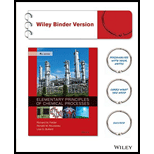
Concept explainers
(a)
Interpretation:
A flow diagram for the process needs to be drawn and the molar amount of product stream component along with extent of reaction needs to be determined.
Concept introduction:
Flow chart for the process is determined on the values of input and output that is the amount of feed entered in the reactor and product is formed also helps to predict the amount accumulated during formation of product.
For a single reaction system, the final moles of each of the components present can be estimated by the equation:
Here,
The values of number of moles for product stream calculation is based on the number of moles for product is calculated from feed stream that is product formed with respect to the feed consumed reference need to be taken from given reaction
(b)
Interpretation:
An assumption for which the value of energy balance
Concept introduction:
The amount of heat transferred can be represented as follows:
Here,
Enthalpy of reactant and product depends upon the specific heat and the temperature difference.
(c)
Interpretation:
The value of
Concept introduction:
The amount of heat transferred is represented as follows:
Here,
Enthalpy of reactant and product depends upon the specific heat and the temperature difference.
(d)
Interpretation:
Percentage error for outlet temperature Tout is to be calculated for given condition.
Concept introduction:
The amount of heat transferred is represented as follows:
Here,
And,
Enthalpy of reactant and product depends upon the specific heat and the temperature difference.
(e)
Interpretation:
Based on the value of Tout , whether it was a potential error or not needs to be determined for the given condition.
Concept introduction:
The amount of heat transferred is represented as follows:
Here,
And,
Where,
Enthalpy of reactant and product depends upon the specific heat and the temperature difference.
Want to see the full answer?
Check out a sample textbook solution
Chapter 9 Solutions
Elementary Principles of Chemical Processes, Binder Ready Version
 Introduction to Chemical Engineering Thermodynami...Chemical EngineeringISBN:9781259696527Author:J.M. Smith Termodinamica en ingenieria quimica, Hendrick C Van Ness, Michael Abbott, Mark SwihartPublisher:McGraw-Hill Education
Introduction to Chemical Engineering Thermodynami...Chemical EngineeringISBN:9781259696527Author:J.M. Smith Termodinamica en ingenieria quimica, Hendrick C Van Ness, Michael Abbott, Mark SwihartPublisher:McGraw-Hill Education Elementary Principles of Chemical Processes, Bind...Chemical EngineeringISBN:9781118431221Author:Richard M. Felder, Ronald W. Rousseau, Lisa G. BullardPublisher:WILEY
Elementary Principles of Chemical Processes, Bind...Chemical EngineeringISBN:9781118431221Author:Richard M. Felder, Ronald W. Rousseau, Lisa G. BullardPublisher:WILEY Elements of Chemical Reaction Engineering (5th Ed...Chemical EngineeringISBN:9780133887518Author:H. Scott FoglerPublisher:Prentice Hall
Elements of Chemical Reaction Engineering (5th Ed...Chemical EngineeringISBN:9780133887518Author:H. Scott FoglerPublisher:Prentice Hall
 Industrial Plastics: Theory and ApplicationsChemical EngineeringISBN:9781285061238Author:Lokensgard, ErikPublisher:Delmar Cengage Learning
Industrial Plastics: Theory and ApplicationsChemical EngineeringISBN:9781285061238Author:Lokensgard, ErikPublisher:Delmar Cengage Learning Unit Operations of Chemical EngineeringChemical EngineeringISBN:9780072848236Author:Warren McCabe, Julian C. Smith, Peter HarriottPublisher:McGraw-Hill Companies, The
Unit Operations of Chemical EngineeringChemical EngineeringISBN:9780072848236Author:Warren McCabe, Julian C. Smith, Peter HarriottPublisher:McGraw-Hill Companies, The





